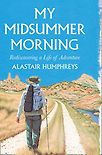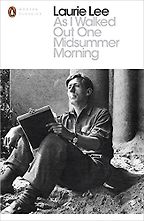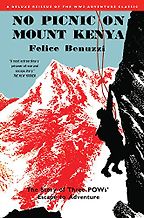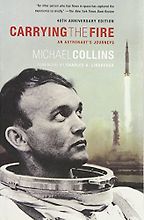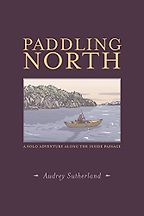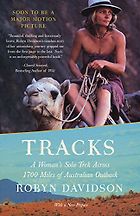You’ve chosen the best books written by adventurers, of which you’re one: you’ve bicycled around the world, you’ve rowed across the Atlantic amongst other adventures. But I get the feeling, looking through these books you’ve chosen, that you don’t have to do anything quite as hardcore to qualify as an adventurer. Basically, any of us can be an adventurer, if we want to, is that right?
Belatedly, I’ve come to believe that. When I first started reading books about adventure, I was fully into the hardcore epic, smashing out the whole world or else nothing at all. I was smitten by people doing the really crazy stuff and that’s what I was aspiring towards in my own life for many years.
Then, gradually, as I’ve done adventures and experienced the benefits of them, I’ve come to see that it’s much broader than that. And I suppose also as I’ve grown up and gotten older and have felt that macho need to prove how tough I am to the world less often, my attitude has softened. So yes, these days I’m very much about adventure being a choice of attitude.
So how did you choose these adventure books? I thought one element they have in common is that these adventurers all have a sense of humour. They make jokes in their books.
There’s quite a lot of adventure writing that takes itself very seriously. It’s very earnest and there’s a lot of macho showing off, which gets a bit tiresome. I don’t like anybody who takes themselves too seriously. The best adventures I’ve been on, and the favourite people I’ve been on expeditions with, do a good line in self-deprecating humour, even in quite grim circumstances. And I think that’s an essential trait when you’re doing something really tough, and are really suffering, to be able to laugh about it. Often it’s a choice of we can either laugh now or we can cry.
So I like books where people are pushing themselves hard and doing difficult things but also retaining a bit of perspective, that it’s only voluntary suffering. It’s essentially about trying to get something out of life by playing a game. It’s not really that much different from sport. As someone said about sport, it doesn’t matter at all, but people treat it as though it does. That’s what gives adventure its piquancy, I suppose.
What kind of people does adventure attract, do you think?
It attracts people who are a bit rubbish at everything else in life and have a big chip on their shoulder, quite often; people who are not very good at things growing up and see this as a chance to prove something to themselves and to the world. There are a huge number of people with those issues in adventure. In terms of the big, tough expeditions, there are a surprisingly large number of men who for various reasons have no father figure in their lives. That wasn’t the case for me, I was in the former camp, of having a chip on my shoulder.
“These days I’m very much about adventure being a choice of attitude”
Then, on the more positive side of adventure, there are the people who are curious and restless and conscious that time is short and the world is big and amazing. They don’t wish to settle. Settling is what mud does in a pond. So the restlessness keeps people going as well.
What’s the scariest thing that’s ever happened to you on an adventure? When were you most frightened?
There are various different types of fear on adventures. There’s the fear that I get in the middle of the Atlantic Ocean, in the dark, when the waves are enormous and a storm has hit the boat. That’s a fairly blunt kind of fear.
Then, cycling around the world and arriving in some big, big city like Mexico City or Cairo, you have that anxious nervousness of trying to find somewhere safe to stay and feeling lonely amongst millions and millions of people.
On my trip through Spain, there was a huge amount of fear that came out of standing up in a small village plaza on a sunny day and trying to play my violin. That’s a strange fear that’s based on vulnerability, shame and embarrassment.
The final fear for me is the one I’ve always had on trips of beginning. Walking across India, when I stood on the beach about to begin, I was so afraid of the scale of what I was taking on and the unknowns, that I found it very hard to just make myself go. But I’ve got into the habit of pigheadedly just doing it anyway. I remember so clearly how 10 minutes later I was walking down this sandy little track in India absolutely delighted with the fact that I was doing this. But minutes earlier, I’d been terrified. It’s a strange thing, getting started.
On that note, let’s talk about Laurie Lee’s wonderful book, As I Walked Out One Midsummer Morning. You’ve written elsewhere that this is your favourite book, and I suspect you’re not the only one. Tell me why you like it so much, and for those who don’t know it, what it’s about.
As I Walked Out One Midsummer Morning is about a young man in the 1930s who, one day in early June, walks out from the little village where he grew up. He waves goodbye to his mum at the garden gate and goes to explore, to have an adventure—as young people have done since the beginning of time, I suppose. He makes his way to Spain and then he walks the length of Spain. He plays his violin to pay his way, sleeping out on the hills, playing in bars and talking to people. He’s just living a very simple but idyllic-sounding life.
It’s quite a short book and it’s very beautifully and poetically written. I first read it when I was at university, and at the time I was completely smitten with these crazy hardcore stories of South Pole suffering and mountaineers chopping off their own arms. I loved all that sort of stuff. Reading Laurie Lee was suddenly a very different perspective on adventure, because he was just a normal young guy. He was not very tough. He wasn’t very fit. He didn’t claim to be trying to do anything extraordinary. He was just out in the world, living vividly and being curious and I loved that, mostly because it sounded like me. I enjoyed reading the big tough expedition books partly because I felt that was quite distant from what my personality was, but Laurie Lee felt very much like me. Ever since I read As I Walked Out One Midsummer Morning I thought I wanted to go and do the trip myself. I kept reading the book every couple of years for about 15 years, but kept putting off actually doing anything about it.
But then you did it and you wrote a book about it, My Midsummer Morning: Rediscovering a Life of Adventure. Tell me a bit about it.
So rather than walking across Spain playing my violin, I spent years doing all sorts of other stuff, the big trips we’ve talked about. I gradually started to notice, though, that the reasons I was doing those big trips—for the excitement and the risk and the fear of failure and the uncertainty—because I’d been doing this sort of stuff for about 20 years, I’d got quite good at it and therefore a lot of those things had faded away. I realized that carrying on with big adventures was just my own version of being in a rut and a routine and a comfort zone.
I wanted to try to look differently at adventure, and what adventure meant to me, and also to try and find a way to get back those thrills and uncertainties. So I decided what I needed to do was something that I was very bad at, that I’d never done before and was really daunting to me. That’s when I came up with the idea of taking up the violin, learning it and then trying to walk through Spain for a month with no money or credit cards and only my appalling musical skills to see me through.
You mention in the book that Laurie Lee was better at the violin, but could say only one phrase of Spanish, whereas your Spanish was quite good, but your violin playing was appalling.
Yes. Normally when someone says, ‘I’m bad at the violin’ everyone thinks they’re just being modest. The benefit of listening to the audiobook version of my book is that it actually has some of my violin playing. When I got home, I kept practising and managed to pass grade one violin—so I was worse than that when I began. If you’ve heard a six-year-old playing a violin you’ll know about how bad I was.
Laurie Lee was really good at the violin, but he’d never been on an adventure and had never spoken Spanish before. So what he got out of that trip was quite different to me. My Spanish was fine. I’d been abroad many times and I’d done long walks. But I can’t really play the violin and the idea of standing up in public and performing is something that scares me greatly. I hate karaoke. I hate dancing. I find it mortifyingly embarrassing. So having to do that in order to get money was, for me, at least as frightening as some of the bigger expeditions I’ve done.
When you made five euros busking in a day that was a windfall, is that right? How did it work out in terms of getting by?
Before the trip began, I was really sure I was going to be borderline starvation, rummaging in bins, stealing crusts off café tables, pinching corn from fields. That was how I anticipated it would go.
And you did do a bit of that, didn’t you?
No, no!
I seem to recall you were rummaging in a bin at one point in the book?
Oh yes, I did once find some pork scratchings in a bin, but that was just luck, I wasn’t trying to rummage. On the very first day I actually earned four euros, which I was just ridiculously thrilled about. You can have a feast for four euros. In the whole month I earned 120 euros, so four euros a day, but I had this rule that in every town, whenever I earned money, I had to spend all of that money that day. I couldn’t hoard it up because I wanted, when I got to the next village, to be back at zero again, to be hungry and afraid and vulnerable. So it was quite feast or famine. One day, for example, I earned 20 euros. It was a Sunday morning and I ate ice creams and peanuts and all sorts of luxury things. Then, the next day, I was back to carrot sandwiches.
That was the staple, carrot sandwiches?
It was carrot sandwiches when times were hard. My staple was banana sandwiches. That’s been my staple for many, many years on adventures.
Your book, My Midsummer Morning: Rediscovering a Life of Adventure, is very much reflecting on life and trying to figure something out about yourself. Is Laurie Lee’s As I Walked Out One Midsummer Morning like that as well?
It’s completely different. For starters, Laurie is about 20 when he arrives in Spain. He is a young man filled with the joys of youth, of wine, women and song—literally those three. That essentially keeps him going happily through Spain, having the best time of his entire life. In my head, that is how I always imagined myself, as an adventurer. I still see myself as that carefree, young spirit, but the reality of my life is that I am now a middle-aged man with two kids.
“How can I still be this adventurous individual, this carefree spirit I see myself as, and also be a stay-at-home, sensible Dad?”
That becomes quite an important part of the book, this struggle I have figuring out: how can I still be this adventurous individual, this carefree spirit I see myself as, and also be a stay-at-home, sensible Dad who is paying the mortgage and taking my kids to football lessons? The frustration I had, this feeling that I was not doing either side of my life justice, is one of the things that finally booted me out the door to go and do this walk.
Have you talked to any other adventurers and explorers about how they deal with that transition?
It’s one of those things we don’t really write about. Pretty much all adventure books involve ‘Person goes off does something heroic. Isn’t life brilliant? The End.’ My reality from all my own experiences—and I also have a lot of friends who do stuff like this and write books—is that almost without exception there’s a huge anticlimax and a down period after trips. You come back and think, ‘Wow, I’ve done this amazing thing. But I’m still the same me. I still have all the insecurities or itchiness or whatever it was that drove me away in the first place.’
Pretty much everyone I know has had a big slump after their trips. But it’s not really written about, because it’s much more exciting just to write about getting to the top of the mountain.
Are divorce rates high in the adventurer profession?
I suspect they are, because if you want to go and be a hardcore adventurer, you have to be pretty spectacularly selfish. I’ve certainly found that a big struggle in my life, between the selfish and ambitious me versus trying to be a good husband and a good dad.
Essentially it comes down to a choice. The choice for me happened quite a few years ago, when I had a choice between going to the South Pole—this expedition I’d spent five years training and preparing for—and leaving behind my young family or quitting those big, extreme expeditions and trying to learn to become a new version of me.
Reading about Edmund Hillary, it sounds like he managed to balance his life. He made the transition from mountaineering to setting up charities.
He did the ideal thing, which is go away when you’re young, do something incredibly crazy and epic—but do it just because you want to do it, not because you’re trying to get famous. He hated being famous. Then you’ve got that out of your system and can get on and do other good stuff in your life. He’s a person who did a very good job of it.
Next let’s talk about No Picnic on Mount Kenya by Felice Benuzzi. So he’s an Italian working in the Italian administration in Ethiopia and ends up in a prisoner of war camp in Kenya during World War 2. And from there, he spots Mount Kenya in the distance . . .
What I love about this book is that he’s just a normal guy, living a normal life who gets swept into a prisoner of war camp. The scale of World War II is just incredible, it pretty much swept up everybody. In the camp, it’s incredibly boring. They’re Italian, just chilling out without their daily espressos and not bothering to escape, like Brits were supposed to do. Even if they could escape they’re 6,000 miles from Italy, so it’s impossible.
They’re just bored out of their brains, and to make matters either better or worse, out in the distance, beyond the barbed wire, is this beautiful skyline with Mount Kenya. Benuzzi was trapped in a prison and out there was this big mountain, this symbol of adventure and freedom. He was quite a good climber so just for fun, really, and to idly pass the time, he started daydreaming about breaking out of prison to climb the mountain. It just drove him mad until eventually he did it: escaped, climbed the mountain and then, because they were Italian and not that keen on anything else, they broke back into the prison camp, apologized for escaping, and sat out the rest of the war.
Mt Kenya is quite technical at the top. How did how did they manage it, because presumably they had zero equipment?
One of the fun parts of the book is that it goes against the modern cult of feeling you need to spend $500 on a raincoat to walk your dog. They had to get all the gear they needed to climb a pretty difficult mountain out of what they could beg, borrow, steal and make in the prison camp. So they made crampons out of barbed wire. They made ice axes out of hammers they stole. They had to hoard tiny bits of food to make supplementary rations—and they were underfed prisoners in the first place. That’s one of the joys of the book: working out how you cobble together the equipment you need in secret, without getting caught, before even breaking out of the camp.
And yes, the mountain is quite hard. It’s high and it’s cold. So they had to make all the gear, escape from prison, trek through the lowlands—through the dangerous wild animals of Africa—and then climb a pretty serious technical mountain, all while malnourished.
Are there any hairy moments when they nearly die?
It’s pretty treacherous climbing and they failed. They didn’t actually get to the top of the top. There are a few different peaks and they got to a lower down one.
But the climbing part isn’t really what this book is about. It’s about the human spirit and the lust and quest for adventure and the feeling that freedom and adventure can overcome anything, even being in prison. I really enjoy it now because so many of us in modern life like to moan that we can’t have adventures because…and then you insert an excuse: lack of time, lack of money, I haven’t got an expensive raincoat, whatever. I love the fact that they didn’t let anything stand in their way.
I also enjoy the fact that when they break back into prison at the end, although they’ve committed a serious offence by escaping, the British officer just gives them a very short spell in solitary confinement because he’s proud of their ‘sporting effort.’
Let’s go on to your next book, which is Tracks by Robyn Davidson. She writes, “The lunatic idea was basically . . .” Tell us what her lunatic idea was.
Robyn Davidson was a young woman living an urban life in Australia and came up with the idea that she’d really like to cross the desert in Australia by camel. The problem was that she had literally no experience of anything to do with camels, the outdoors or adventure and she had pretty much zero money. So that was the starting premise for her project.
She took a train to Alice Springs as she figured that would be a good place to start. She spent a couple of years learning how to look after camels before she even began. So that’s an interesting part of the book, the commitment and effort needed to even get to the starting line of the trip. She has to overcome so many obstacles: not just all of the skills she needed, but also the tough male culture of The Outback: men thinking that she, being a Sheila, has got no chance of making it. There were all sorts of problems and disasters before she even began.
I read the bit where she’s trying to learn the camel trade from a man called Kurt. He’s pretty hard work.
He basically shafts her of everything in the end. He doesn’t keep his promise at all. He’s a horrible person and she has a terrible time.
With No Picnic on Mt Kenya I love the story, but it’s not that well-written. Tracks is just fantastically well written. Also, I don’t know if you’ve ever seen the photography for it? One of the comedy parts of the trip is that in order to fund it, she manages to persuade National Geographic to cover her story. She writes for them but they, quite understandably, insist on sending a photographer. He’s a bit of a bumbling young fool of a man who turns up every month or two. She’s always furious at him for invading her privacy. So that’s the comedy/romantic side of the trip, but the pictures he took are absolutely astonishing. She’s incredibly beautiful. He’s an amazing photographer and the landscape is extraordinary. When I first saw the pictures, I assumed they were fake and for a film, rather than the actual ones.
And so she’s trying to get to the coast. How many miles is it?
It’s about 1700 miles. She goes from Alice westwards until she hits the Indian Ocean. She’s got a train of camels and they’ve never seen the ocean. When they get to the end, suddenly there’s more water than they’ve ever seen but they can’t drink it. So they’re quite uncertain about it.
I didn’t realize there were feral camels living in Australia. Are they still there now?
Yes, there are loads of them. They’re quite a problem. Wild feral male camels are big scary things and in the book they come along and try and take her female camels. She has to defend herself against feral camels a couple of times and even has to shoot one, at one point. They can be quite aggressive creatures, it seems.
So the next book is by somebody who is more in the hardcore explorer camp. This is Carrying the Fire: An Astronaut’s Journeys by Michael Collins. He’s the man who stayed in the spaceship while Neil Armstrong and Buzz Aldrin went down to walk on the Moon. I’ve tried his name out on a few people and nobody seems to have heard of him.
That’s exactly why I was fascinated. Pretty much everyone on the planet knows Neil Armstrong and Buzz Aldrin, but not Michael Collins. His job was to fly up and then, when the other two went in the landing capsule down to the Moon, he had to stay in the command module until they came back. While the other two were on the Moon, he orbited around it. He was the loneliest human in history, round the dark side of the Moon on his own. It’s extraordinary. He also knew that if anything went wrong with the landing craft—which it was very, very likely that it would—he would have to press the go-back-to-Earth-on-my-own button and leave his two friends on the Moon to die.
“He was the loneliest human in history, round the dark side of the Moon on his own”
What initially captivated me about Michael Collins is the way he says, ‘I’d be lying if I said that I had the best seat in the spaceship. Of course I’d have liked to go to the Moon, but wow, what a privilege it was to do what I did. I had an incredible experience.’ Whereas Buzz Aldrin has spent the last 50 years of his life being more angry about being second on the Moon than happy about going to the Moon.
What I really liked about Carrying the Fire as a moon landing book is that he goes through the whole run-up to Apollo 11. He was a test pilot. They took classes in geology. He also says that he didn’t want a ghost-writer, he wanted to write the book himself. By the time I finished the book, I felt like I’d been there with him in the command module, going round the back of the moon. He also makes jokes, like when he messages Neil and Buzz and reminds them to have lunch. “The Jewish mother in orbit,” he quips. I really enjoyed it.
I really enjoyed all the training, build-up side of things as well—and the human side of the book. It’s such a rocket science-type endeavour, but Michael Collins seems like a really nice guy. He manages to tell the story of this incredible effort by elite people in a way that’s quite relatable and interesting.
Carrying the Fire has been recommended before on Five Books, it’s supposed to be the best of the astronaut memoirs.
Another great book is Moondust by Andrew Smith. He does his best to interview all 12 people who have been to the Moon. I really enjoyed that book as well.
So last on your list of books by adventurers we have Paddling North by Audrey Sutherland. This is quite an encouraging book, because she starts her adventures quite late. As we head towards the end of middle age, we can still become adventurers.
Audrey Sutherland is not particularly famous in the adventuring world. I only stumbled across her because Patagonia, the clothing company, published some of her writing. She was just a woman living a normal, if slightly quirky, life with a normal-ish office job until she was in her 50s. Then she has this moment of looking in the mirror and she says to herself, ‘Why, you’re not getting any younger, are you?’ And from there she sets off. She does carry on her normal life, but every summer she goes off for a couple of months, kayaking up the beautiful coastline of Alaska through all the inlets and islands.
Five Books interviews are expensive to produce. If you're enjoying this interview, please support us by donating a small amount.
She does some pretty tough, brave paddling but in a very relaxed, eccentric way. She’s got an inflatable kayak, a little yellow rubber dinghy basically, and she puts a very high priority on finding a scenic campsite every evening and cooking delicious food. I like that balance of things she does.
Isn’t it quite precarious to go in an inflatable canoe off the coast of Alaska?
Kayaking on your own is always quite dangerous anyway, but there are some extremely strong currents and very high tides. She has to do some quite big crossings, across open water from place to place. It’s way further than I would dare paddle in an inflatable kayak, so she’s pretty bold with what she’s doing. But she’s not on some great mission to prove something to the world, or to be the first to do x,y or z. She’s just going around doing what makes her feel excited, really.
She’s got a bit of an itinerary though, doesn’t she?
She’s trying to plot her way bit by bit right the way up the Alaskan coastline. She’s not ambling around, she does have an itinerary, but just for her own satisfaction.
She starts with a joke about meeting a grizzly bear. Does she meet bears and stuff?
She meets vast numbers of bears and wolves and killer whales or orcas. On Robyn Davidson’s trip she seems to be mostly encountering horrible scary men, whereas Audrey Sutherland seems to be mostly encountering wild beasts. She deals with them fairly phlegmatically.
What I liked about her book is just how down to earth it was and the priorities she has. Her reasons for adventure were quite different to a lot of stuff I’ve read. For example, she has recipes in the book. She makes a real effort to collect bits of seaweed and wild garlic along the way. She seems to have her priorities nicely sorted. Also, it’s quite inspiring that she began as a late middle-aged woman to do these sorts of things. She’s not this big strong person either.
Are her recipes good ones if you’re going on an adventure?
There’s one recipe she calls ‘Bear Bars’, which is essentially her homemade flapjacks that she takes on the trip. It’s a fairly standard recipe, but she says not to make them more than 24 hours before the trip begins or you’ll have eaten them all before you start. Then she writes about cooking wild mussels and things she can forage along the seashore. It’s stuff that you can make in the wild but it’s by no means survivalist food. And she takes along olive oil and she always takes a bottle of wine with her in the boat.
But the takeaway of the book, the line that stands out for me is when she says, ‘Go simple, go solo, go now.’ It’s an amazing summary of how people should just get on with their adventures.
Five Books aims to keep its book recommendations and interviews up to date. If you are the interviewee and would like to update your choice of books (or even just what you say about them) please email us at [email protected]

